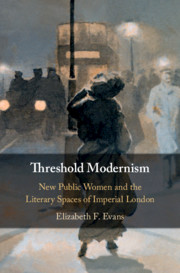Book contents
- Threshold Modernism
- Threshold Modernism
- Copyright page
- Dedication
- Contents
- Figures
- Acknowledgments
- Introduction London, 1880–1940: Liminal Sites and Contested Identities
- Chapter 1 Modern Sites for Modern Types: Locating the New Public Woman
- Chapter 2 Shops and Shopgirls: The Modern Shop, “Counter-Jumpers,” and the Shopgirl’s Narrative Evolution
- Chapter 3 Streets and the Woman Walker: When “Street Love” Meets Flânerie
- Chapter 4 Women’s Clubs and Clubwomen: “Neutral Territory,” Feminist Heterotopia, and Failed “Diplomacy”
- Chapter 5 New Public Women Through Colonial Eyes: Reverse Imperial Ethnography
- References
- Index
- References
References
Published online by Cambridge University Press: 30 November 2018
- Threshold Modernism
- Threshold Modernism
- Copyright page
- Dedication
- Contents
- Figures
- Acknowledgments
- Introduction London, 1880–1940: Liminal Sites and Contested Identities
- Chapter 1 Modern Sites for Modern Types: Locating the New Public Woman
- Chapter 2 Shops and Shopgirls: The Modern Shop, “Counter-Jumpers,” and the Shopgirl’s Narrative Evolution
- Chapter 3 Streets and the Woman Walker: When “Street Love” Meets Flânerie
- Chapter 4 Women’s Clubs and Clubwomen: “Neutral Territory,” Feminist Heterotopia, and Failed “Diplomacy”
- Chapter 5 New Public Women Through Colonial Eyes: Reverse Imperial Ethnography
- References
- Index
- References
- Type
- Chapter
- Information
- Threshold ModernismNew Public Women and the Literary Spaces of Imperial London, pp. 228 - 251Publisher: Cambridge University PressPrint publication year: 2018



